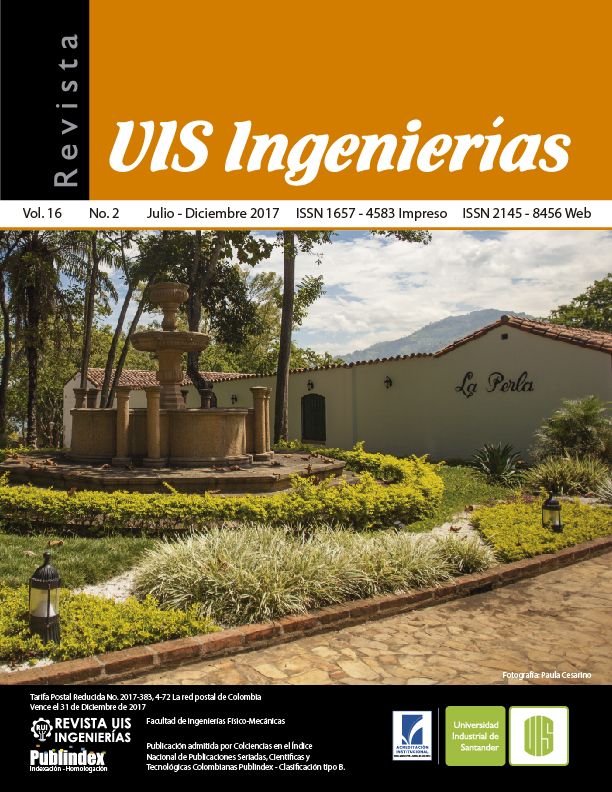Publicado 2017-05-17
Palabras clave
- Generación fotovoltaica,
- Mitigación térmica,
- Irrigación
Cómo citar
Resumen
La irrigación de la superficie superior de los paneles fotovoltaicos (FV) es uno de los métodos más efectivos para reducir su temperatura de operación e incrementar la potencia generada. Aunque existen publicaciones sobre esta técnica, hay poca información sobre el efecto de las variaciones del tiempo de irrigación y caudal de riego. Este trabajo presenta un estudio experimental sobre el efecto de estos dos factores para un panel FV de 255 W instalado en un entorno de clima cálido tropical. Se encontró que caudales de 4.5 l/min o superiores pueden producir incrementos de hasta 10% en la energía generada adicional diaria; adicionalmente, que los tiempos de irrigación tienen una significativa influencia en la disminución de la temperatura de operación promedio y la energía adicional generada por un panel FV.
Descargas
Referencias
H. a Hussien, A. H. Numan, and A. R. Abdulmunem, “Improving of the photovoltaic / thermal system performance using water cooling technique,” IOP Conf. Ser. Mater. Sci. Eng., vol. 78, p. 12020, 2015.
A. Molki, “Temperature effect on photovoltaic cells,” Phys. Educ., vol. 46, no. 5, pp. 523–525, 2011.
J. M. Olchowik et al., “Influence of temperature on the efficiency of monocrystalline silicon solar cells in the South-eastern Poland conditions,” Mater. Sci., vol. 24, no. 4, p. 6, 2006.
F. Ju and X. Fu, “Research on impact of dust on solar photovoltaic(PV) performance,” 2011 Int. Conf. Electr. Control Eng. ICECE 2011 - Proc., pp. 3601– 3606, 2011.
S. Krauter, “Increased electrical yield via water flow over the front of photovoltaic panels,” Sol. Energy Mater. Sol. Cells, vol. 82, no. 1–2, pp. 131–137, 2004.
C. Lamnatou and D. Chemisana, “A critical analysis of factors affecting photovoltaic-green roof performance,” Renew. Sustain. Energy Rev., vol. 43, pp. 264–280, 2015.
D. Chemisana and C. Lamnatou, “Photovoltaicgreen roofs: An experimental evaluation of system performance,” Appl. Energy, vol. 119, pp. 246–256, Apr. 2014.
H. G. Teo, P. S. Lee, and M. N. a Hawlader, “An active cooling system for photovoltaic modules,” Appl. Energy, vol. 90, no. 1, pp. 309–315, 2012.
A.-M. Croitoru and A. Badea, “Air cooling of photovoltaic panels from passive house located inside the University Politehnica of Bucharest,” UPB Sci. Bull. Ser. C Electr. Eng., vol. 75, no. 3, pp. 277–290, 2013.
G. George, X. Kanavas, and D. Zissopoulos, “ADAM, intelligent integrated self-enhanced photovoltaic panel with Rainwater harvesting for Irrigation, unit cooling and cleaning,” Proc. 24th Int. Conf. Eur. Assoc. Educ. Electr. Inf. Eng. EAEEIE 2013, pp. 174–177, 2013.
H. M. Bahaidarah, S. Rehman, P. Gandhidasan, and B. Tanweer, “Experimental Evaluation of the Performance of a Photovoltaic Panel with Water Cooling,” in Photovoltaic Specialists Conference (PVSC), 2013 IEEE 39th. Tampa, Florida, USA, 2013, pp. 2987–2991.
S. Odeh and M. Behnia, “Improving Photovoltaic Module Efficiency Using Water Cooling,” Heat Transf. Eng., vol. 30, no. 6, pp. 499–505, 2009.
E. L. Meyer and M. Busiso, “Comparative study of a directly cooled PV water heating system to a naturally cooled module in South Africa,” Conf. Rec. IEEE Photovolt. Spec. Conf., pp. 1296–1299, 2012.
A. Kordzadeh, “The effects of nominal power of array and system head on the operation of photovoltaic water pumping set with array surface covered by a film of water,” Renew. Energy, vol. 35, no. 5, pp. 1098–1102, 2010.
H. M. S. Bahaidarah, A. A. B. Baloch, and P. Gandhidasan, “Modeling and Comparative Analysis of Jet Impingement Cooling and Conventional Channel Cooling for Photovoltaic Strings,” IEEE 40th Photovolt. Spec. Conf., pp. 748–753, 2014.
T. Reindl et al., “Investigation of the Performance of Commercial Photovoltaic Modules under Tropical Conditions,” Jpn. J. Appl. Phys., vol. 51, p. 4, 171
M. Habiballahi, M. Ameri, and S. H. Mansouri, “Efficiency Improvement of Photovoltaic Water Pumping Systems by Means of Water Flow Beneath Photovoltaic Cells Surface,” J. Sol. Energy Eng., vol. 137, no. 4, p. 44501, 2015.
M. K. Smith et al., “Water cooling method to improve the performance of field-mounted, insulated, and concentrating photovoltaic modules,” J. Sol. Energy Eng. Trans. ASME, vol. 136, no. August, pp. 1–4, 2014.
P. P. Vergara-Barrios, J. M. Rey-López, G. A. Osma-Pinto, and G. Ordóñez-Plata, “Evaluación del potencial solar y eólico del campus central de la Universidad Industrial de Santander y la ciudad de Bucaramanga, Colombia,” UIS Ingeniería, vol. 13, no. 2, pp. 49–57, 2014.

